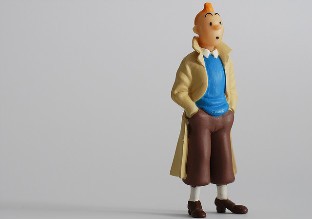Saved by Tintin

From where I sit at the family dinner table my eyes fall on a tall bookcase, on top of which, just under a map of Narnia, a crowd of small resin figures seems to be in perpetual motion. One of them, the diva Bianca Castafiore, is singing the "Jewel" aria from Gounod's Faust, but if she is not run over by two detectives in bowler hats driving a green 1926 Citroën 5HP, she will soon be knocked down by Professor Calculus walking in an intellectual trance, or by Captain Haddock pacing the deck. Interspersed among these characters, smaller than the rest, yet the reason for their very existence, is Tintin, the young reporter, standing in his blue sweater and brown plus fours before a preternaturally large Amanita muscaria mushroom, scaling a craggy cliff in kilt and tam, trekking in a pith helmet and khaki shorts, crouching in a porcelain vase with his white terrier Snowy.
Down in the basement—but we've just carted them upstairs to get reacquainted—are the 23 original Tintin books we've collected over the past three decades. When we first discovered Tintin, while studying abroad in Paris, he was almost unknown in the U.S. We liked to think of him as our private enthusiasm. All that has changed: with the release of the Stephen Spielberg and Peter Jackson film, Tintin belongs to the world.
The creator of Tintin, Georges Remi—whose initials, reversed, produced the pen name Hergé—was the brightest star of the Franco-Belgian school of cartoon illustration (bandes dessinées). Hergé pioneered what he called the ligne claire (clear line), strong black outlines without shading or crosshatching, illuminated like a book of hours by layers of flat, saturated color. Each object has a similar value, whether it is the wake of a ship, a line of prayer flags or a bottle of whiskey concealed in Captain Haddock's pocket. There is plenty of movement, but nothing hectic or extraneous. While disciples of Hergé have used the clear line method for ironic effect (Where's Waldo? is a good example), in Hergé's hands it suggests moral clarity. One has only to look at Tintin, his round face animated by the simplest imaginable features, to know that he is Pure Heart (as the high lama calls him in Tintin in Tibet), defender of the weak and downtrodden, loyal, resilient, ever youthful, endlessly cheerful and tolerant of the foibles of his eccentric friends, never cowed by evil—the ultimate Boy Scout.




